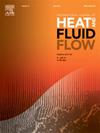Sparsity-promoting methods for isolating dominant linear amplification mechanisms in wall-bounded flows
IF 2.6
3区 工程技术
Q2 ENGINEERING, MECHANICAL
International Journal of Heat and Fluid Flow
Pub Date : 2025-05-26
DOI:10.1016/j.ijheatfluidflow.2025.109872
引用次数: 0
Abstract
This work proposes a method to identify and isolate the physical mechanisms that are responsible for linear energy amplification in fluid flows. This is achieved by applying a sparsity-promoting methodology to the resolvent form of the governing equations, solving an optimization problem that balances retaining the amplification properties of the original operator with minimizing the number of terms retained in the simplified sparse model. This results in simplified operators that often have very similar pseudospectral properties as the original equations. The method is demonstrated on both incompressible and compressible wall-bounded parallel shear flows, where the results obtained from the proposed method appear to be consistent with known mechanisms and simplifying assumptions, such as the lift-up mechanism, and (for the compressible case) Morkovin’s hypothesis and the strong Reynolds analogy. This provides a framework for the application of this method to problems for which knowledge of pertinent amplification mechanisms is less established.
隔离有壁流动中优势线性放大机制的稀疏性促进方法
这项工作提出了一种方法,以确定和隔离的物理机制,负责在流体流动的线性能量放大。这是通过将稀疏性促进方法应用于控制方程的求解形式来实现的,该方法解决了一个优化问题,该问题平衡了保留原始算子的放大特性与最小化简化稀疏模型中保留的项数。这导致简化算子通常具有与原始方程非常相似的伪谱性质。该方法在不可压缩和可压缩的壁界平行剪切流中得到了证明,其中从所提出的方法得到的结果似乎与已知的机制和简化的假设相一致,例如抬升机制,以及(对于可压缩的情况)Morkovin假设和强雷诺兹类比。这为将该方法应用于有关放大机制的知识较少建立的问题提供了一个框架。
本文章由计算机程序翻译,如有差异,请以英文原文为准。
求助全文
约1分钟内获得全文
求助全文
来源期刊

International Journal of Heat and Fluid Flow
工程技术-工程:机械
CiteScore
5.00
自引率
7.70%
发文量
131
审稿时长
33 days
期刊介绍:
The International Journal of Heat and Fluid Flow welcomes high-quality original contributions on experimental, computational, and physical aspects of convective heat transfer and fluid dynamics relevant to engineering or the environment, including multiphase and microscale flows.
Papers reporting the application of these disciplines to design and development, with emphasis on new technological fields, are also welcomed. Some of these new fields include microscale electronic and mechanical systems; medical and biological systems; and thermal and flow control in both the internal and external environment.
 求助内容:
求助内容: 应助结果提醒方式:
应助结果提醒方式:


